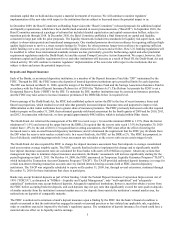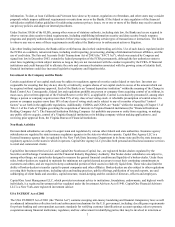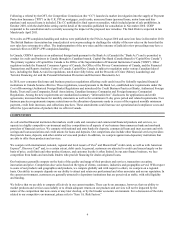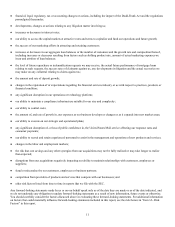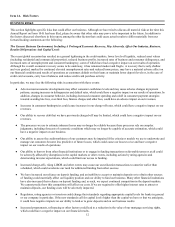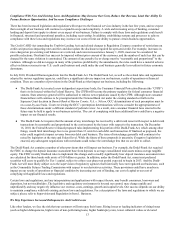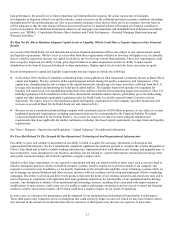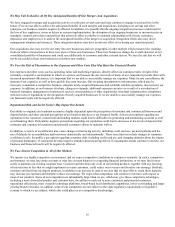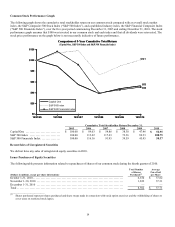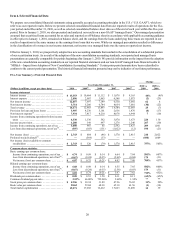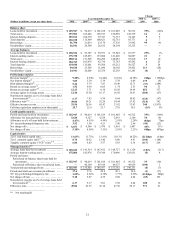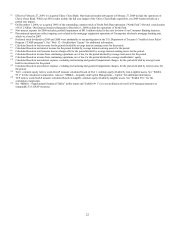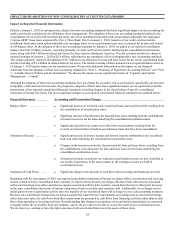Capital One 2010 Annual Report Download - page 35
Download and view the complete annual report
Please find page 35 of the 2010 Capital One annual report below. You can navigate through the pages in the report by either clicking on the pages listed below, or by using the keyword search tool below to find specific information within the annual report.15
loan performance, the actual level of future repurchase and indemnification requests, the actual success rate of claimants,
developments in litigation related to us and the industry, actual recoveries on the collateral and macroeconomic conditions (including
unemployment levels and housing prices). Due to uncertainties relating to these factors, there can be no assurance that our reserves
will be adequate or that the total amount of losses incurred will not have a material adverse effect upon our financial condition or
results of operations. For additional information related to our mortgage loan repurchase and indemnification obligations and related
reserves, see “MD&A—Consolidated Balance Sheet Analysis and Credit Performance—Potential Mortgage Representation and
Warranty Liabilities.”
We May Not Be Able to Maintain Adequate Capital Levels or Liquidity, Which Could Have a Negative Impact on Our Financial
Results
As a result of the Dodd-Frank Act and international accords, financial institutions will become subject to new and increased capital
and liquidity requirements. While it is not yet clear what form these requirements will take or how they will apply to us, it is possible
that we could be required to increase our capital levels above the levels in our current financial plans. These new requirements could
have a negative impact on our ability to lend, grow deposit balances or make acquisitions and on our ability to make capital
distributions in the form of increased dividends or share repurchases. Higher capital levels could also lower our return on equity.
Recent developments in capital and liquidity requirements that may impact us include the following:
● In December 2010, the Basel Committee on Banking Supervision published a final framework (commonly known as Basel III) on
capital and liquidity. The key elements of the capital proposal include raising the quality, consistency and transparency of the
capital base, strengthening the risk coverage of the capital framework, introducing a leverage ratio that is different from the U.S.
leverage ratio measures and promoting the build-up of capital buffers. The liquidity framework includes two standards for
liquidity risk supervision, one standard promoting short-term resilience and the other promoting longer-term resilience. How U.S.
banking regulations will be modified to reflect these international standards remains unclear, particularly given the forthcoming
capital and other prudential requirement regulations under the Dodd-Frank Act and the current Prompt Corrective Action
framework. We expect, however, that minimum capital and liquidity requirements for the Company and other institutions will
increase as a result of Basel III, the Dodd-Frank Act and related activity.
● Because we are a consolidated bank holding company with consolidated assets of $50 billion or greater, we are subject to certain
heightened prudential requirements, including requirements that may be recommended by the Financial Stability Oversight
Council and implemented by the Federal Reserve. As a result, we expect to be subject to more stringent standards and
requirements than those applicable for smaller institutions, including risk-based capital requirements, leverage limits and liquidity
requirements.
See “Item 1. Business—Supervision and Regulation—Capital Adequacy” for additional information.
We Face Risk Related To The Strength Of Our Operational, Technological And Organizational Infrastructure
Our ability to grow and compete is dependent on our ability to build or acquire the necessary operational, technological and
organizational infrastructure. We have substantially completed significant development projects to complete the systems integration of
Chevy Chase Bank and to build a scalable banking infrastructure. Implementation of such infrastructure changes and upgrades may, at
least temporarily, cause disruptions to our business, including, but not limited to, systems interruptions, transaction processing errors
and system conversion delays, all of which could have a negative impact on us.
Similar to other large corporations, we are exposed to operational risk that can manifest itself in many ways, such as errors related to
failed or inadequate processes, faulty or disabled computer systems, fraud by employees or persons outside of our company and
exposure to external events. In addition, we are heavily dependent on the strength and capability of our technology systems which we
use to manage our internal financial and other systems, interface with our customers and develop and implement effective marketing
campaigns. Our ability to develop and deliver new products that meet the needs of our existing customers and attract new ones and to
run our business in compliance with applicable laws and regulations depends on the functionality of our operational and technology
systems. Any disruptions or failures of our operational and technology systems, including those associated with improvements or
modifications to such systems, could cause us to be unable to market and manage our products and services or to report our financial
results in a timely and accurate manner, all of which could have a negative impact on our results of operations.
In some cases, we outsource the maintenance and development of our operational and technological functionality to third parties.
These third parties may experience errors or disruptions that could adversely impact us and over which we may have limited control.
Any increase in the amount of our infrastructure that we outsource to third parties may increase our exposure to these risks.


